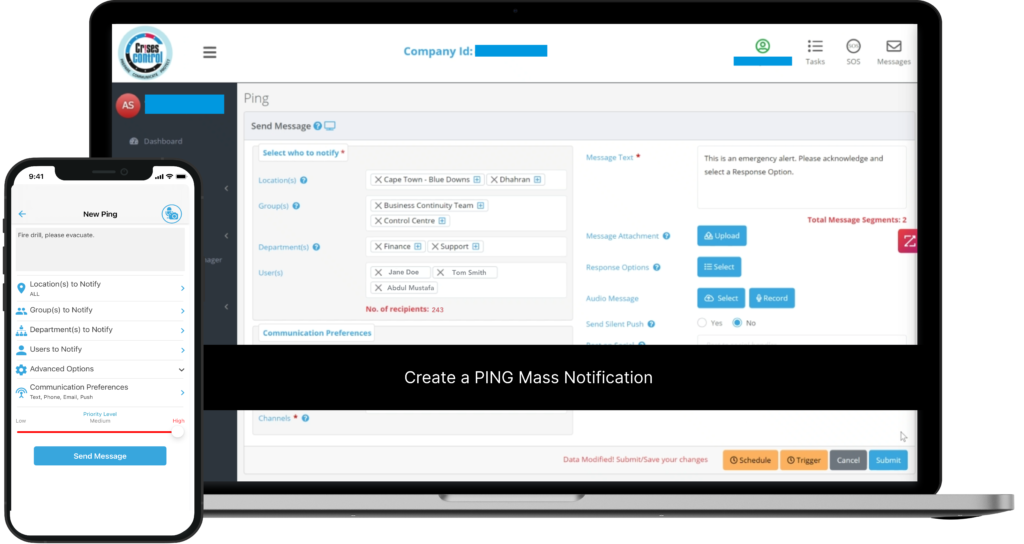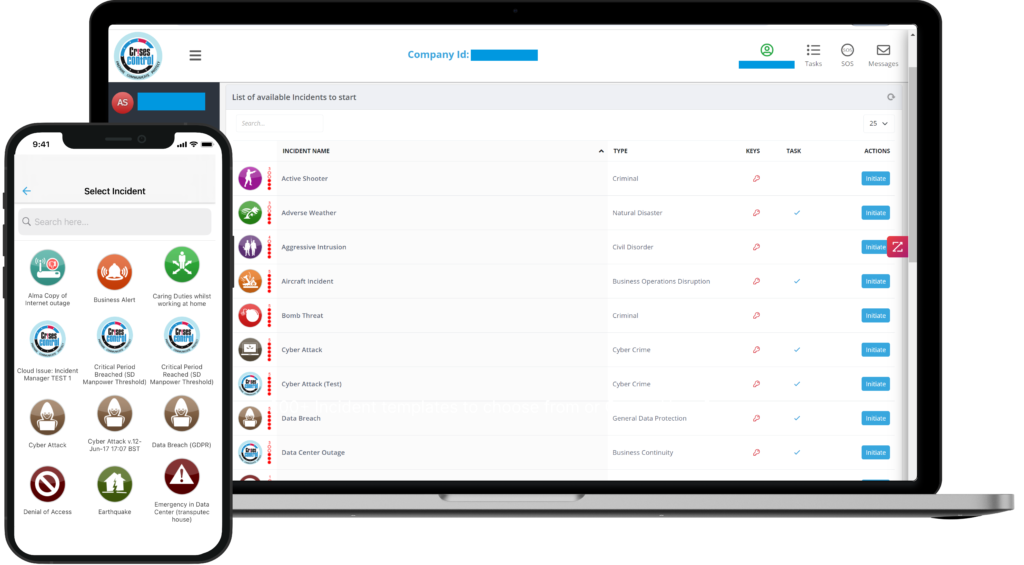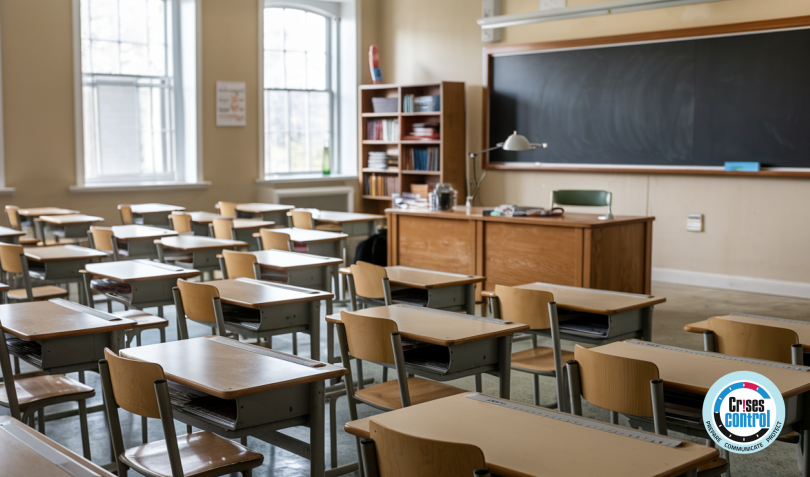Written by Anneri Fourie | Marketing Executive
School safety is more crucial than ever, given the challenges schools face, from severe weather to medical emergencies and lockdown situations. One effective solution is a Mass Notification System. These systems ensure that the right people receive timely information during an emergency.
In this blog, we’ll explore how Mass Notification Systems can enhance school safety and how Crises Control can help create a secure learning environment.
The Growing Need for Mass Notification Systems in Schools
Understanding School Safety Challenges
Schools are responsible for keeping students, staff, and visitors safe, a task made more complex by increasing emergencies, such as severe weather or active shooter situations. Traditional communication methods like PA systems and call trees often fail under high-stress conditions, leading to delays and confusion. These outdated methods can put lives at risk when immediate action is needed.
Are you confident that your school’s current safety measures can keep everyone informed and safe during a crisis?
PA systems are limited to specific areas and can be difficult to hear in emergencies, while call chains are slow and error-prone. These limitations highlight the need for more reliable communication tools, like Mass Notification Systems, designed to ensure everyone gets the critical information they need quickly and accurately.
How Mass Notification Systems Enhance School Safety
Real-Time Communication for Immediate Response
Mass Notification Systems offer real-time alerts across multiple channels, ensuring that everyone—students, staff, and parents—receives crucial information instantly, regardless of their location. This approach bridges the gap left by traditional methods, enabling quicker and more effective responses during emergencies.
Scenario: Imagine a severe weather alert, like a tornado warning. Instead of relying on a PA announcement, the system can instantly send instructions to everyone to take shelter, reducing response time and enhancing overall safety.
Automated Alerts to Minimise Mistakes
With Mass Notification Systems, automated alerts for various emergencies—such as lockdowns or severe weather—are pre-programmed and sent with just one click. This reduces the chance of errors and ensures that clear, consistent messages are delivered quickly, even under pressure.
Scenario: During a medical emergency, the system can immediately notify the school nurse and key staff members, while also updating parents. This ensures a coordinated and efficient response without delays.
Two-Way Communication for Staying Informed
Unlike older methods, Mass Notification Systems allow for two-way communication, enabling school administrators to receive real-time updates from staff and students. This continuous feedback is crucial for understanding the situation and making informed decisions.
Scenario: In a lockdown, teachers can provide real-time updates on their students’ status, helping administrators coordinate with law enforcement and make better decisions. This ongoing communication helps maintain calm and ensure safety.
Interested in our Ping Mass Notification Software?
Efficiently alert everyone in seconds at scale with our Mass Notification System – PING, get the message out fast and ensure rapid response and recovery.

Practical Applications of Mass Notification Systems in Schools
Lockdown Situations
During a lockdown, quick communication is vital to keep everyone safe. Mass Notification Systems can instantly send clear, direct instructions to staff, students, and parents, helping everyone stay calm and informed.
Example: If a suspicious person is spotted on campus, the system can immediately send a lockdown alert to all classrooms and security teams. Parents receive real-time updates, which reassures them and provides instructions on where to pick up their children.
Severe Weather Alerts
Weather emergencies like tornadoes or floods require immediate action. Mass Notification Systems use real-time weather data to send alerts, guiding everyone to safety promptly.
Example: A severe thunderstorm warning triggers a school-wide alert, directing students and staff to designated safe zones inside the building. Administrators can provide live updates as the situation evolves.
Fire and Evacuation Drills
Clear communication during evacuations is essential. Mass Notification Systems simplify the process by providing step-by-step instructions, minimising confusion and ensuring everyone knows the correct procedures.
Example: During a fire drill, the system sends teachers detailed instructions on which exits to use and where to assemble. It also communicates when it’s safe to return, reducing downtime and ensuring an orderly evacuation.
Medical Emergencies
Speed is crucial during medical emergencies. Mass Notification Systems can alert medical staff, notify emergency services, and keep everyone updated, ensuring a swift response.
Example: A student suffers a severe allergic reaction, and the system immediately alerts the school nurse, emergency contacts, and nearby trained staff. This rapid, coordinated response ensures the student gets the help they need right away.
How Crises Control Can Help Schools
Multi-Channel Communication and Real-Time Alerts
Crises Control’s Ping Mass Notification System leverages SMS, calls, emails, and app notifications to guarantee that no critical information is overlooked. This multi-channel approach ensures that every member of the school community—whether students, staff, or parents—receives essential updates immediately. By using diverse communication methods, Crises Control minimises the risk of missed messages during emergencies, ensuring that everyone is informed and able to act swiftly.
Incident Management and Automation
Crises Control’s automation features streamline emergency responses by pre-programming actions for different scenarios. This automation significantly reduces the risk of human error, ensuring that critical alerts are dispatched quickly and efficiently. By eliminating manual steps, Crises Control helps school administrators execute emergency protocols flawlessly, saving valuable time and reducing stress during high-pressure situations.
Two-Way Messaging and SOS Panic Button
The two-way messaging feature in Crises Control enables staff to send real-time updates during emergencies, which helps administrators stay informed and make well-coordinated decisions. This continuous flow of information enhances situational awareness and supports better decision-making. Additionally, the SOS Panic Button offers a discreet and immediate way for staff to request urgent assistance, ensuring that help arrives swiftly and efficiently, thereby enhancing overall safety.
Seamless Integration and Compliance
Crises Control’s seamless integration with existing school systems, such as PA systems and security cameras, ensures that all components of the school’s safety infrastructure work together harmoniously. This integration enhances the effectiveness of emergency responses and guarantees that safety protocols are followed without interruption. Moreover, by adhering to safety standards and regulations, Crises Control helps schools maintain compliance and provides peace of mind, knowing that their emergency systems are both effective and legally sound.

Interested in our Incident Management Software?
Customise your Crisis Incident Management Software to meet your specific needs with our flexible tools & stay connected and informed during the crisis and incident management process
Steps to Implement Mass Notification Systems in Schools
- Identify Communication Gaps: Review your current communication methods to find areas needing improvement. Assess how quickly and effectively your existing systems can reach all members of the school community during an emergency.
- Select the Right System: Choose a system that offers reliability, ease of use, and multi-channel communication. Crises Control provides a comprehensive solution that enhances your school’s emergency response capabilities.
- Budget Considerations: Evaluate the cost and ensure the system aligns with your school’s budget. Consider the long-term value of improved safety and peace of mind for students and staff when making your decision.
- Train Staff and Conduct Drills: Effective training and emergency drills are essential. Start with small-scale drills to familiarise staff with the system, and gradually incorporate more complex scenarios to build confidence and readiness.
- Check Compatibility: Ensure the Mass Notification System integrates with existing school technologies, such as PA systems, security cameras, and access control systems. Seamless integration helps maintain a unified approach to school safety.
Conclusion: Create a Safer School Environment with Crises Control
Mass Notification Systems are crucial for creating a safe school environment, providing quick and reliable communication when it matters most. By effectively managing lockdowns, severe weather, and medical emergencies, these systems enhance your school’s safety and help protect students and staff.
Ready to elevate your school’s safety measures? Contact Crises Control today to schedule a free personalised demo and discover how our Mass Notification Systems can transform your school’s emergency response.
Request a FREE Demo

